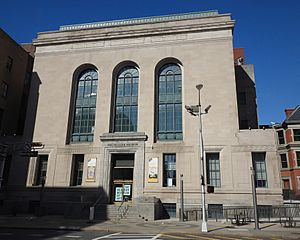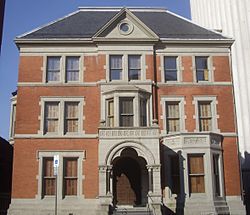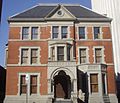The Newark Museum of Art facts for kids
 |
|

The Newark Museum of Art seen from Washington Park
|
|
| Established | 1909 |
|---|---|
| Location | 49 Washington St Newark, New Jersey, U.S. |
| Public transit access | Washington Park Station (Newark Light Rail) |
|
James Street Commons Historic District
|
|
|
U.S. Historic district
Contributing property |
|

John Ballantine House
|
|
| Lua error in Module:Location_map at line 420: attempt to index field 'wikibase' (a nil value). | |
| NRHP reference No. | 78001758 |
| Significant dates | |
| Added to NRHP | January 9, 1978 |
The Newark Museum of Art is the biggest museum in Newark, New Jersey, USA. It used to be called the Newark Museum. This amazing place has huge collections of art from America, Asia (especially a large collection of Tibetan art), Africa, and even ancient times. You'll also find decorative arts and modern art here. Famous American artists like Thomas Cole, Mary Cassatt, and Georgia O'Keeffe have their works displayed.
But it's not just art! The Newark Museum of Art also loves natural science. It has the Dreyfuss Planetarium, where you can explore space. The Victoria Hall of Science shows off cool items from the museum's collection of 70,000 natural science specimens. Outside, the Alice Ransom Dreyfuss Memorial Garden is a beautiful spot with sculptures. It's also used for fun community events, concerts, and shows. In the garden, you can find an old stone schoolhouse from 1784 and the Newark Fire Museum.
The museum was started in 1909 by a librarian named John Cotton Dana. His idea was to create a museum in Newark to show art, science, history, and technology. The very first collection was a group of Japanese prints, silks, and porcelains.
Contents
History of the Museum
The museum first opened on the fourth floor of the Newark Public Library. In the 1920s, it moved into its own special building on Washington Park. This move was possible thanks to a gift from Louis Bamberger. The building was designed by Jarvis Hunt.
Over the years, the museum has grown bigger many times. It expanded into a former YMCA building and also into the historic 1885 Ballantine House. A big renovation in the 1980s and 1990s helped the museum add more space. In 1990, the museum expanded again into another building.
For about 20 years, the museum even had a mini-zoo with small animals. This closed in August 2010.
In 1997, the museum closed its main front entrance. This was done to protect the artwork from changes in temperature and humidity. But after a big renovation and adding a ramp for easy access, the front doors reopened in February 2018.
On November 6, 2019, the museum changed its name to "The Newark Museum of Art." This new name helps show how important its art collection is. The museum's art collection is considered one of the best in the country. The Newark Black Film Festival used to be held at the museum every summer.
You can visit the museum on Thursdays and Fridays from 12 PM to 7 PM. On Saturdays and Sundays, it's open from 10 AM to 5 PM. On the third Friday of each month, the museum stays open later, until 9 PM.
Amazing Tibetan Art
The museum has some of the best Tibetan art galleries in the world. The collection was bought from Christian missionaries in the early 1900s. The Tibetan galleries even have a special Buddhist altar that the Dalai Lama himself has blessed.
How the Collection Started
In 1910, a missionary named Albert L. Shelton lent his Tibetan art collection to the museum. This was for a special exhibition in 1911, which was the first of its kind in the world. It was a big success! Sadly, a museum trustee named Edward N. Crane passed away that same year. His family bought the collection from Shelton and gave it to the museum to honor Crane. The museum also asked Shelton to bring back more items between 1913 and 1920 to add to the collection.
Before 1935, the Tibetan art pieces were shown one by one, with descriptions. This was how other museums like the Victoria and Albert Museum in London displayed their collections. But in 1935, the Newark Museum built a temporary altar to make the collection feel more special. Visitors loved it so much that the museum decided to keep it permanently. Later, Tibetan monks and important guests visited and blessed the altar space.
The museum kept adding more objects to its collection until the 1940s. It now has over 5,000 items! These include paintings, sculptures, special religious objects, beautiful fabrics, and decorative arts.
Modern Tibetan Galleries
In the mid-1980s, the museum started a project called "Tibet, the Living Tradition." This involved renovating and expanding the galleries to create eight permanent display areas. The original altar was re-blessed in 1988. It was then placed inside a new altar created by a Tibetan artist named Phuntsok Dorje between 1989 and 1990. The 14th Dalai Lama blessed this new altar in 1990. As of 2019, the museum has over 5,500 Tibetan art items. This makes it the largest and most unique collection in the Western Hemisphere.
Besides the art, the museum also has a large collection of old photographs and films of Tibet. There are more than 2,500 pictures taken between 1904 and 1949, and hours of film footage from 1935 to 1937.
The Ballantine House
The Ballantine House is a beautifully preserved house from the Victorian Era. It was designed by architect George Edward Harney. This house was once home to John Holme Ballantine, his wife Jeannette, and their four children. Mr. Ballantine owned a brewery in Newark. The house originally had 27 rooms spread across three floors! In 1937, the Newark Museum bought the house. They have since restored it to show off their amazing collections of decorative arts.
See also
 In Spanish: Museo de Arte de Newark para niños
In Spanish: Museo de Arte de Newark para niños
- Explorers Program at Newark Museum
Images for kids


